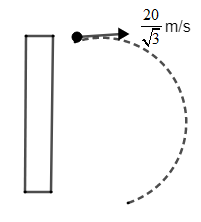
A particle is projected horizontally with a speed of $\dfrac{20}{\sqrt{3}}m/s$ from some height at t=0. At what time will this velocity make ${{60}^{o}}$ angle with the initial velocity.

$\begin{align}
& A.1\sec \\
& B.2\sec \\
& C.1.5\sec \\
& D.2.5\sec \\
\end{align}$

Answer
555.9k+ views
Hint: Study the given diagram to understand the provided system. Then, find out the vertical component of velocity using the equation of motion. Then calculate the time at which the horizontal component of velocity makes an angle of ${{60}^{o}}$ with an initial velocity.
Formula used:
Use the formula of the first equation of motion
$v=u+at$
Complete answer:
As we know, particle is projected horizontally and initial horizontal component of the velocity of particle is ${{v}_{h}}=\dfrac{20}{\sqrt{3}}m/s\text{ at }t\text{=0}......\left( 1 \right)$
Now there is no acceleration in the horizontal direction. So the horizontal component of velocity will remain the same initial vertical component of velocity of the particle is ${{v}_{v}}=0$ because the particle is along the horizontal direction. Therefore, its initial vertical component is zero. This will change with time because of acceleration due to gravity having value$g=10m/{{s}^{2}}$.
Suppose after the time t sec the velocity of the particle makes an angle of ${{60}^{o}}$with initial velocity in the horizontal direction. After time t vertical component will be $v_{v}^{1}={{v}_{v}}+g\times t$
Where ‘$v_{v}^{1}$’ is the final vertical component of velocity after time t, ‘${{v}_{v}}$’ is the initial vertical component of velocity ‘g’ is the acceleration due to gravity, and ‘t’ is the time interval.
By putting values we get,
$\begin{align}
& v_{v}^{1}=0+10t \\
& v_{v}^{1}=10tm/s.....\left( 2 \right) \\
\end{align}$
Now we have to find ‘t’ as we know
$\tan \theta =\dfrac{v_{v}^{1}}{{{v}_{h}}}$
Using (1) and (2) equation, we get
$\begin{align}
& \tan {{60}^{o}}=\dfrac{10t}{\dfrac{20}{\sqrt{3}}} \\
& \sqrt{3}=10t\times \dfrac{\sqrt{3}}{20} \\
\end{align}$
$\sqrt{3}$ Cancel out and after simplifying this we get,
$\begin{align}
& \Rightarrow t=\dfrac{20}{10} \\
& \Rightarrow t=2\sec \\
\end{align}$
So, the correct answer is “Option B”.
Note:
As given in the question, the particle is moving along a horizontal component. Therefore, its vertical component becomes zero. It is suggested to remember the values of acceleration due to gravity that is $g=10m/{{s}^{2}}$ which is a constant value.
Formula used:
Use the formula of the first equation of motion
$v=u+at$
Complete answer:
As we know, particle is projected horizontally and initial horizontal component of the velocity of particle is ${{v}_{h}}=\dfrac{20}{\sqrt{3}}m/s\text{ at }t\text{=0}......\left( 1 \right)$
Now there is no acceleration in the horizontal direction. So the horizontal component of velocity will remain the same initial vertical component of velocity of the particle is ${{v}_{v}}=0$ because the particle is along the horizontal direction. Therefore, its initial vertical component is zero. This will change with time because of acceleration due to gravity having value$g=10m/{{s}^{2}}$.
Suppose after the time t sec the velocity of the particle makes an angle of ${{60}^{o}}$with initial velocity in the horizontal direction. After time t vertical component will be $v_{v}^{1}={{v}_{v}}+g\times t$
Where ‘$v_{v}^{1}$’ is the final vertical component of velocity after time t, ‘${{v}_{v}}$’ is the initial vertical component of velocity ‘g’ is the acceleration due to gravity, and ‘t’ is the time interval.
By putting values we get,
$\begin{align}
& v_{v}^{1}=0+10t \\
& v_{v}^{1}=10tm/s.....\left( 2 \right) \\
\end{align}$
Now we have to find ‘t’ as we know
$\tan \theta =\dfrac{v_{v}^{1}}{{{v}_{h}}}$
Using (1) and (2) equation, we get
$\begin{align}
& \tan {{60}^{o}}=\dfrac{10t}{\dfrac{20}{\sqrt{3}}} \\
& \sqrt{3}=10t\times \dfrac{\sqrt{3}}{20} \\
\end{align}$
$\sqrt{3}$ Cancel out and after simplifying this we get,
$\begin{align}
& \Rightarrow t=\dfrac{20}{10} \\
& \Rightarrow t=2\sec \\
\end{align}$
So, the correct answer is “Option B”.
Note:
As given in the question, the particle is moving along a horizontal component. Therefore, its vertical component becomes zero. It is suggested to remember the values of acceleration due to gravity that is $g=10m/{{s}^{2}}$ which is a constant value.
Recently Updated Pages
Master Class 12 Business Studies: Engaging Questions & Answers for Success

Master Class 12 Economics: Engaging Questions & Answers for Success

Master Class 12 English: Engaging Questions & Answers for Success

Master Class 12 Maths: Engaging Questions & Answers for Success

Master Class 12 Social Science: Engaging Questions & Answers for Success

Master Class 12 Chemistry: Engaging Questions & Answers for Success

Trending doubts
What is meant by exothermic and endothermic reactions class 11 chemistry CBSE

Which animal has three hearts class 11 biology CBSE

10 examples of friction in our daily life

One Metric ton is equal to kg A 10000 B 1000 C 100 class 11 physics CBSE

1 Quintal is equal to a 110 kg b 10 kg c 100kg d 1000 class 11 physics CBSE

Difference Between Prokaryotic Cells and Eukaryotic Cells




